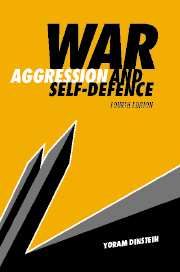Book contents
- Frontmatter
- Contents
- Introduction to the fourth edition
- From the introduction to the first edition
- Table of cases
- Table of treaties
- Table of security council and general assembly resolutions
- List of abbreviations
- Part I The legal nature of war
- Part II The illegality of war
- Part III Exceptions to the prohibition of the use of inter-state force
- 7 The concept of self-defence
- 8 The modality of individual self-defence
- 9 Collective self-defence
- 10 Collective security
- Conclusion
- Index of persons
- Index of subject
8 - The modality of individual self-defence
- Frontmatter
- Contents
- Introduction to the fourth edition
- From the introduction to the first edition
- Table of cases
- Table of treaties
- Table of security council and general assembly resolutions
- List of abbreviations
- Part I The legal nature of war
- Part II The illegality of war
- Part III Exceptions to the prohibition of the use of inter-state force
- 7 The concept of self-defence
- 8 The modality of individual self-defence
- 9 Collective self-defence
- 10 Collective security
- Conclusion
- Index of persons
- Index of subject
Summary
Having dealt in Chapter 7 with diverse problems pertaining to the interpretation of the expression ‘armed attack’ (which constitutes the foundation of the right of self-defence under Article 51 of the Charter of the United Nations), it is now necessary to sketch the optional modes of self-defence available to a State facing an armed attack. At the outset of the discussion it should be pointed out that, for an armed attack to justify counter-measures of self-defence under Article 51, it need not be committed by another State. Ordinarily, the perpetrator of the armed attack is indeed a foreign State as such. Yet, in exceptional circumstances, an armed attack – although mounted from the territory of a foreign State – is not launched by that State. Whether an armed attack is initiated by or only from a foreign country, the target State is allowed to resort to self-defence by responding to unlawful force with lawful counter-force. Given, however, the different features of the two types of armed attack, they will be addressed separately.
Self-defence in response to an armed attack by a State
The expression ‘self-defence’, as used in Article 51 or in customary international law, is by no means self-explanatory. It is a tag attached to the legitimate use of counter-force. Like its corollary (armed attack), self-defence assumes more than one concrete form. The cardinal division, here as elsewhere when the use of force by States is at issue, is between war and measures ‘short of war’.
- Type
- Chapter
- Information
- War, Aggression and Self-Defence , pp. 219 - 251Publisher: Cambridge University PressPrint publication year: 2005
- 2
- Cited by



